I am not a fan of tomato cages, so I went searching for a better trellis for my tomatoes. I had heard all kinds of great things about cattle panels, but getting a bunch of 16-foot long metal things home in a Honda Civic seemed unreal.
Then I stumbled on the Florida Weave, and am SO happy I did.
It’s simple, looks great, and is really effective, plus you only need a few materials (that you probably already have) to get started.
What is the Florida Weave Method?
The Florida Weave is a way to trellis your plants between two lengths of twine. It’s one of the methods farmers use since it’s quicker than individually trellising tomatoes.
You can use this method on both determinate and indeterminate varieties of tomatoes and it’s also a great trellis option for cucumbers, pole beans, peppers, and any plant that needs staking and grows upward.
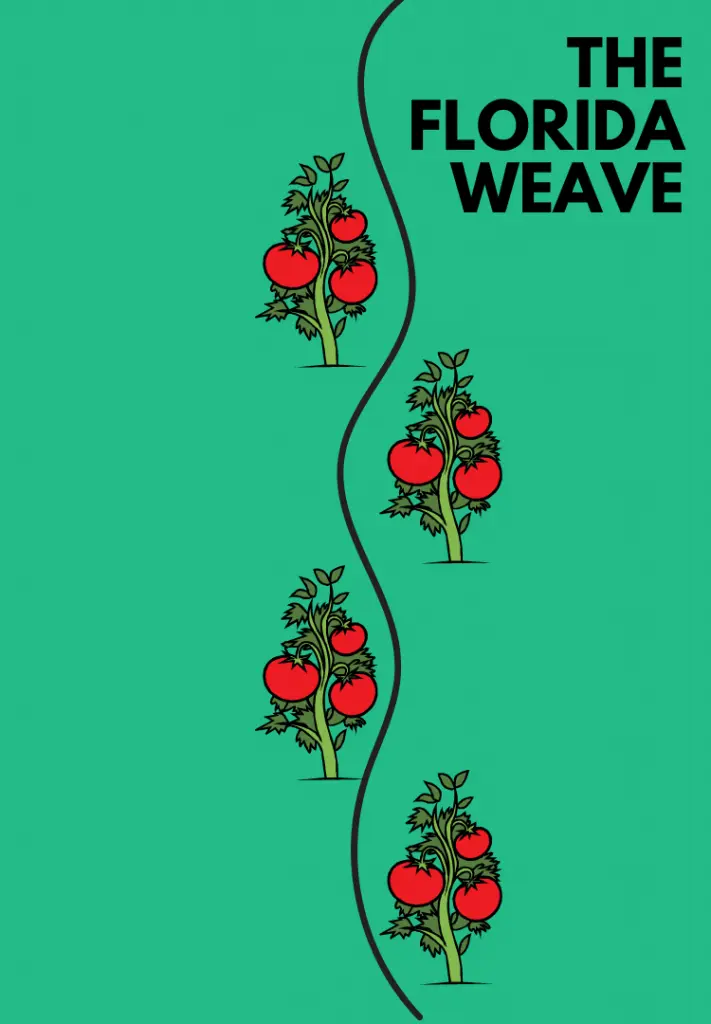
Tips
- Do it before the plants grow lots of roots
What You Need for the Florida Weave System
You don’t need much to start a Florida Weave, but you will want to choose the right materials.
1. Stakes
There are plenty of options you can use for a Florida Weave stake. You’ll want to make sure your stakes are around 6-7 feet tall to accommodate your tomato plants as they grow. Since plants can get up to 5-6 by themselves, you also need to account for a portion of the stake being in the ground.
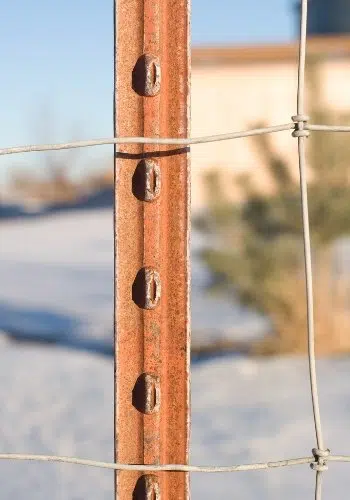
T-Posts
I used T-posts because they won’t bend over time and can be used for a wide variety of things in the garden. They also have looks nooks you better support the twine when you run it around the back of them.
If you go with T-posts, get this and save yourself time getting them in the ground.
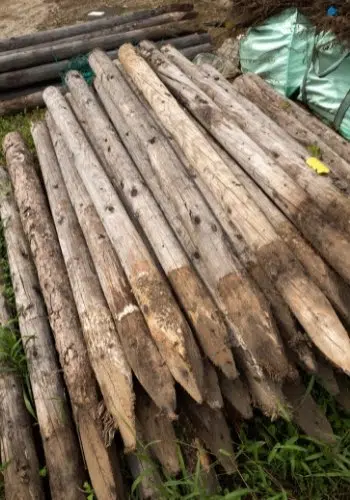
Wooden Stakes
Wooden stakes are often a great option for this (and other) trellis ideas, but with the cost of lumber being so high, it might make sense to choose another option this year.
If you have a ton of trees in your backyard with sturdy branches, you should be able to use those as well.
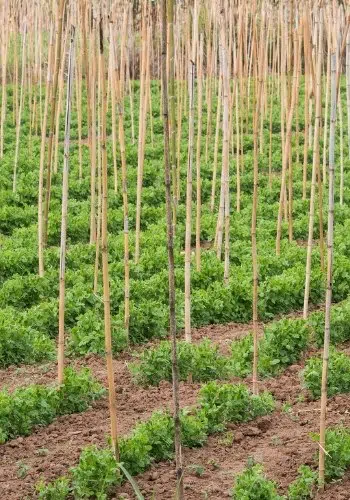
Bamboo Poles
Bamboo is super strong and makes a good option for the Florida Weave, just make sure you get ones that are at least 6 feet tall to support your taller tomato plants.
Rebar
Rebar can be a good option if you get the right size. I bought rebar for this and made the mistake of buying the 1/2 inch wide option, which wasn’t sturdy enough at that height. Go with the thicker version and trying and get ones that are between 6-8 feet tall.
2. Garden Twine AKA Jute
The other thing you’ll need for the Florida Weave is some good quality twine, or what gardener’s call “Jute”.
Look for something that is 3 ply which makes it stronger and more durable to hold up in the rain and wind.
Let’s Get to Weaving!
Alright, now that you have those 2 things covered, we can get started.
1. Placing the Stakes/Posts
I have 50 foot rows, and used 7 T-posts along that route, with one on each end. I spaced them about 8-9 feet apart, and I’ll admit it wasn’t a perfect amount of space in between each. But it was close enough.
I made a really basic plan in Google sheets before I started, just to help me visualize it. Every “X” is a plant, and the thin black lines are T-posts.

Yes, I have 20+ tomato plants, and no, you can’t judge me for it 🙂
I’d recommend keeping the stakes less than 10 feet apart, or else the weight of the plants as they start bearing fruit might be a little too much for the twine.
2. Plant Your Tomato Seedlings
This step comes after the staking because you want to get the stakes in the ground before you plant anything. This makes sure you’re not injuring any established roots as well as getting the spacing right.
Stakes can be placed between every other plant, or farther apart if the stakes are stronger, like T-posts and wooden posts.
3. Starting Weaving
Here’s where the fun begins. About 6-8 inches off the ground is where you’ll want to put your first line.
The basic concept of this method is to support your plants
Securely fasten one end of twine around your first stake. Then pull the twine towards the next stake around the side of your first plant. Move the twine the other side of your second plant, creating enough tension to help support your plants, but not too tight that you damage the stems.
Weave back and forth around the plants until you reach the next stake. Wrap the twine around that second stake a few times for security, and then weave back around the same plants but on the other side of each this time. Repeat this method until you reach the end of the row or the last stake.
The above diagram shows how to do this, and below is a picture of how I set up my Florida weave this year.
The two colored lines show which side each is weaved around the different plants.
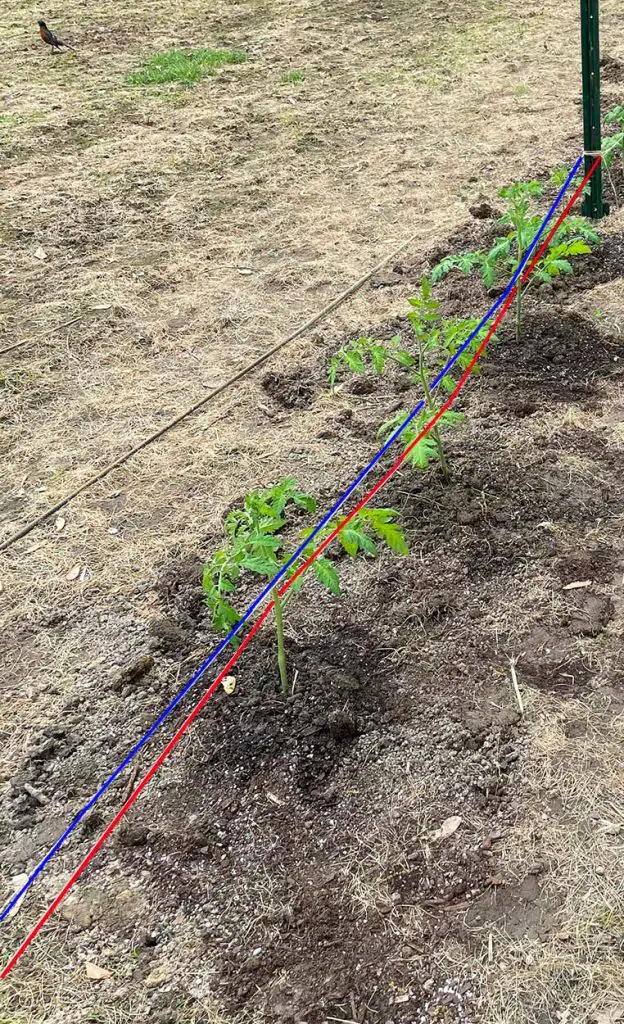
You’ll want to repeat this throughout the gardening season as your plants grow. I like to do this every 6-8 inches of growth to make sure your plants don’t start to droop.
So, you’ll come back in a few weeks, and weave around your tomato stems again, about 6-12 inches above the current weave.
This method allows you to support your plants as they grow, without having to thread them through a tomato cage or cattle panel.
Why a Good Trellis is Important
Good trellising helps create great airflow between your plants and reduces disease. It also seems to make it easier to find tomato worms and pests that might be targeting your precious plants.
If you just let your tomatoes go, especially your indeterminate tomatoes, they will fall over and start growing along the ground.
As you can imagine, this introduces all kinds of issues with water splashing up onto the leaves and causing diseases, and creating a beautiful home for pests like hornworms and aphids.
Can You Florida Weave Cucumbers or Peppers?
You can Florida weave almost any plant that grows upward.


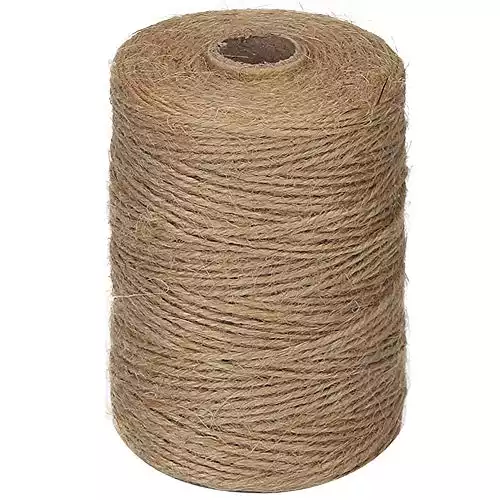

I ordered the Jute in the link and it arrived today. It’s a joke! Tiny little string I fear won’t support much in a stiff breeze.
Hey Walt, I thought the same thing initially, but it held up really well. I had 5 plants on a line at any point, and then tied the ends off on a T-post. This was repeated for 5 sections – yes, I grew too many tomatoes! 🙂 The trick is to stay on top of adding lines as the plants grow up.